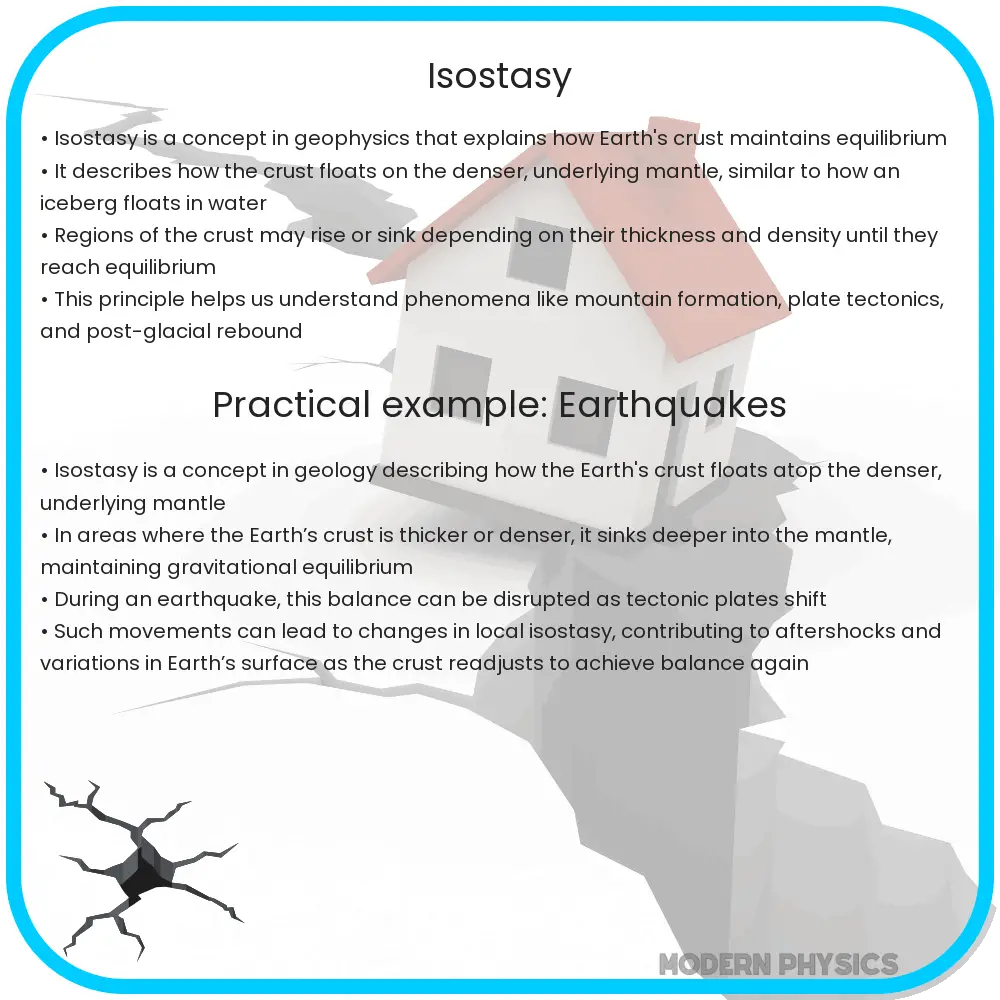Understand isostasy, the principle of buoyancy and balance within the Earth’s crust, explaining its equilibrium and isostatic adjustments.

Understanding Isostasy: The Earth’s Balancing Act
Isostasy is a fundamental geophysical principle that explains the equilibrium between segments of the Earth’s crust. Imagine a wooden block floating in water: if the block is tall, more of it will be submerged compared to a shorter block. This is akin to how the Earth’s crust floats on the semi-fluid asthenosphere beneath it. Isostasy deals with the distribution of mass within the Earth’s crust and how this distribution is balanced by the buoyancy forces at play within the mantle.
The Concept of Isostasy
The Earth’s lithosphere, comprising the crust and the uppermost mantle, is broken into various plates and larger continental landmasses. These differ in thickness and density. Thicker and less dense continental crust “floats” higher on the asthenosphere than the thinner, denser oceanic crust. This form of equilibrium is what we understand as isostatic balance. Just like an iceberg in water, only a portion of the Earth’s unequal crustal blocks are visible above the surface; the rest is compensated for by varying depths into the asthenosphere.
Isostasy is not a rigid or unchangeable state. It’s dynamic. When large ice sheets melt, for example, the weight is lifted from the crust, and an isostatic rebound occurs; the land slowly rises, much like a sponge expanding after being squeezed. This process is evident in areas that were covered by ice sheets during the last glacial period, such as parts of Canada and Scandinavia.
Types of Isostasy
- Airy Isostasy: Propounded by George Biddell Airy in 1855, the Airy model of isostasy suggests that mountain roots (or “roots”) compensate for the height of the mountains. Like floating blocks of wood of different sizes, the crust beneath higher mountains must extend further into the mantle, creating what is known as ‘mountain roots’. This means the crust’s thickness varies to maintain gravitational balance.
- Pratt Isostasy: Rather than varying in thickness, the Pratt hypothesis, proposed by John Henry Pratt in 1859, stipulated that variations in mountain heights are a result of variations in crustal density. Low density regions would rise higher than more dense regions, akin to how varying densities of wood float differently on water.
These models have been refined by incorporating factors like flexural strength of the crust and viscoelastic properties of the mantle to create more comprehensive and accurate representations of crustal deformation.
Isostatic Adjustments
Despite the solid and massive appearance of the Earth’s crust, it is in fact subject to a constant state of adjustment due to isostatic movements. These movements are caused by various factors such as erosional unloading, sedimentation, tectonic activity, and glaciation. The addition or removal of weight from the crust, like the accumulation or melting of ice, can lead to upward or downward adjustments accordingly.
The phenomenon of isostasy demonstrates the robust yet flexible nature of the Earth’s crust, capable of adapting and maintaining equilibrium over geological timescales.
Isostasy and Earth’s Topography
Isostasy significantly influences Earth’s topography. Mountain ranges, plateaus, and even ocean basins owe their existence to isostatic balance. When tectonic forces cause mountains to grow, isostatic forces concurrently work to establish new equilibrium states. This interplay between tectonic uplift and isostatic subsidence shapes the Earth’s landscapes over millions of years.
Similarly, erosion can reduce the height of mountains over time. As the weight of the mountains decrease due to erosion, isostasy causes the crust to rise – a process known as isostatic rebound. This means that while the peaks may get lower, the actual base of the crust underneath can rise, complicating our understanding of Earth’s changing topography.
Human Impact on Isostasy
Human activities like mining, reservoir construction, and groundwater extraction can also cause local isostatic adjustments. For example, the removal of groundwater can lead to subsidence, while the filling of large reservoirs can cause the underlying crust to adjust downward due to the added weight of the water.
This knowledge of isostasy not only helps us understand natural processes but also warns us of the potential geologic consequences of our actions, emphasizing the importance of considering Earth’s isostatic balance in planning and executing large-scale engineering projects.
Isostasy and Climate Change
Isostasy also has implications for climate change. As global temperatures rise, melting of polar ice caps can lead to isostatic adjustment in these regions. The redistribution of water mass from ice to the ocean not only contributes to sea-level rise but also impacts the isostatic balance of the planet, potentially triggering crustal movements that could result in earthquakes or volcanic activity.
Understanding isostasy and its effects on sea-level changes is crucial for predicting future changes in Earth’s geology and for planning coastal infrastructure that could be affected by such alterations.
Conclusion
The powerful yet slow-paced dance of isostasty illustrates the Earth’s capacity for balance and change. Like a ship steadying itself in the water, the Earth’s crust adjusts to the ebb and flow of its own weight distribution and the forces exerted upon it. Through a blend of geological principles such as Airy and Pratt isostasy, we gain insight into the dynamic equilibrium that forms mountains, deep sea trenches, and vast plateaus.
Far from being static, the land beneath our feet is a testament to the ongoing balancing act that has been taking place for eons. The principle of isostasy not only enlightens us about the Earth’s past and shapes the way we understand its present but also prepares us to foresee how it might morph in the future. Whether through natural processes or human-induced changes, the ground we walk on continues a ceaseless dialogue with the forces of nature, striving for balance in an ever-changing world.
